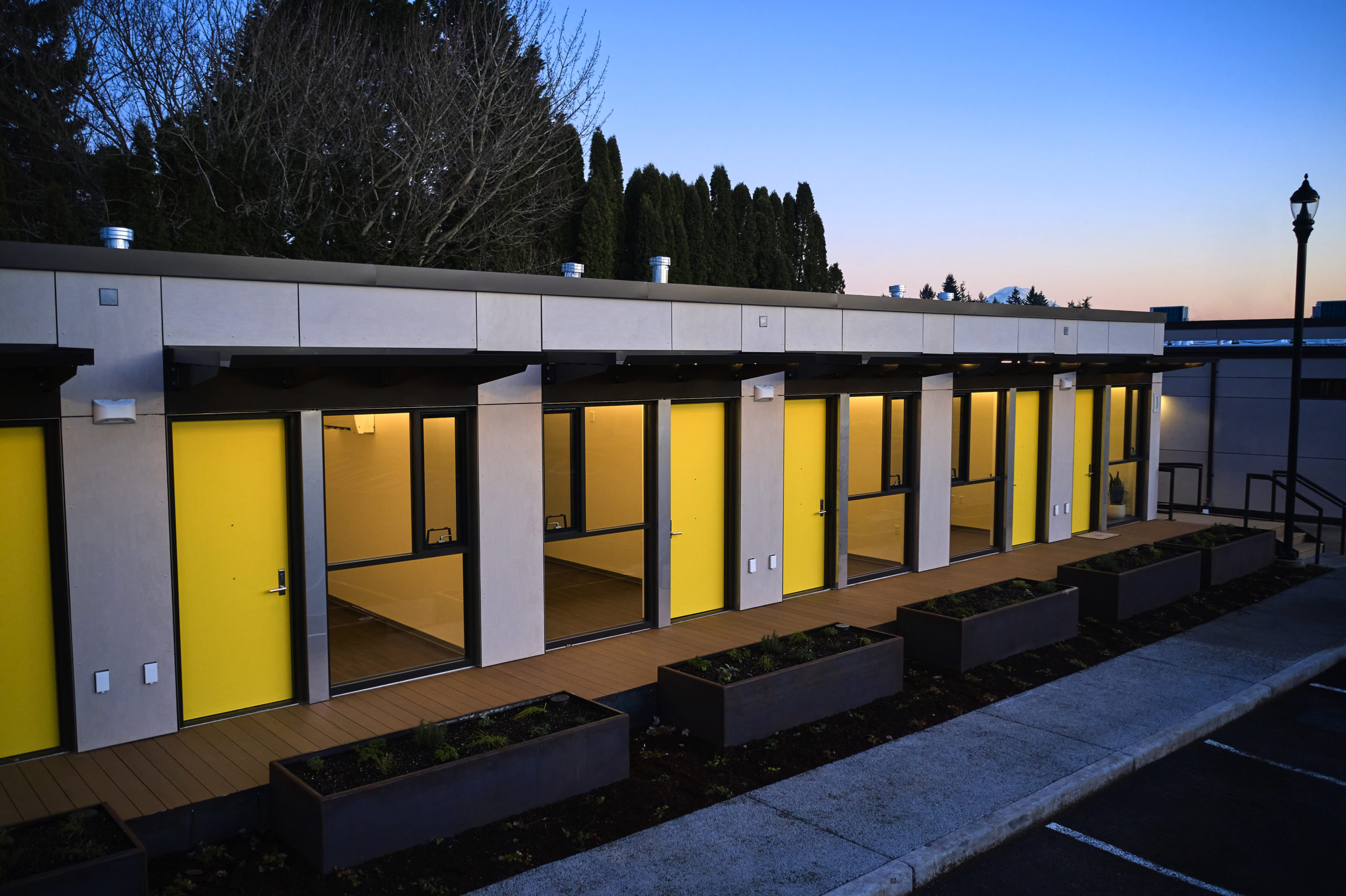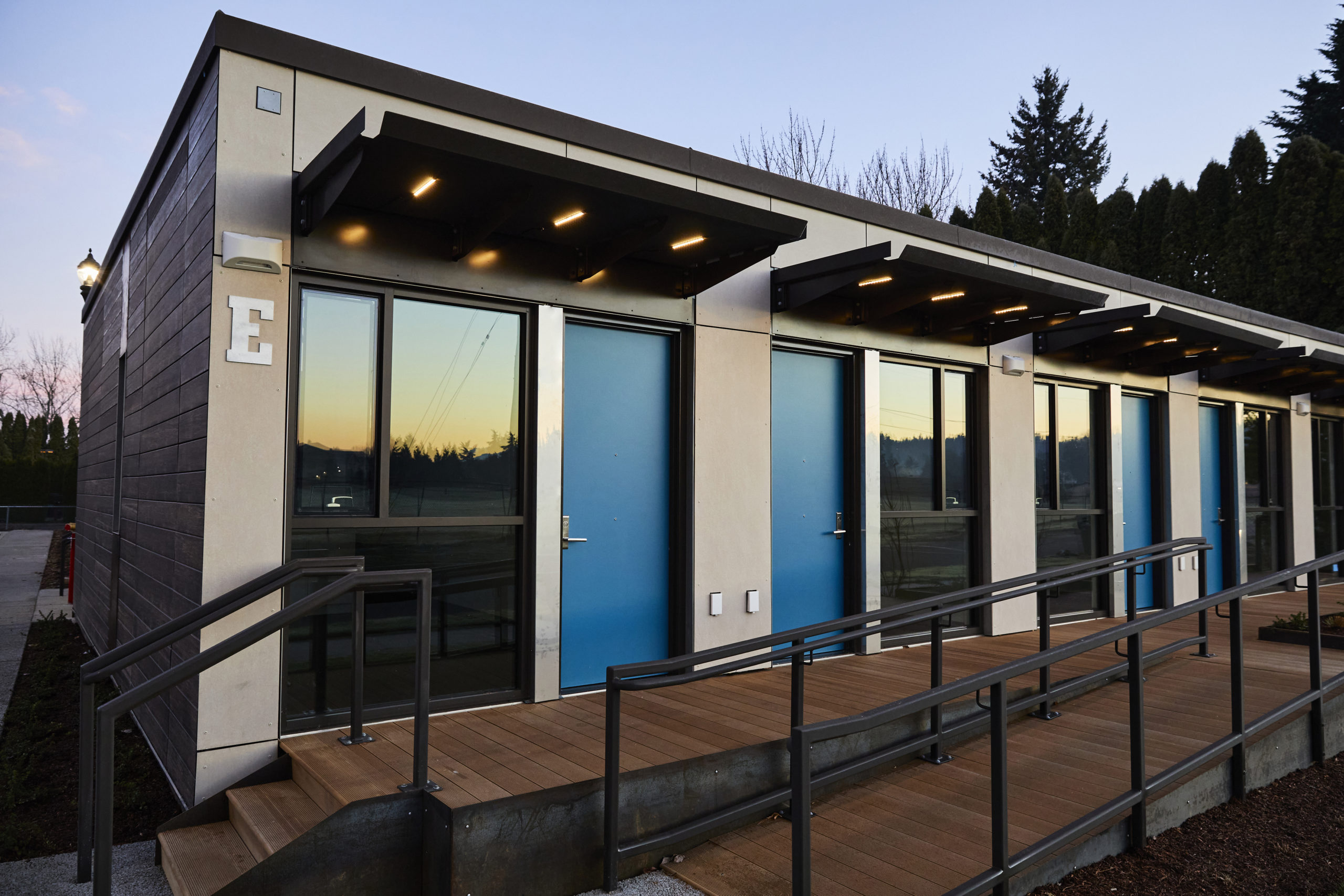Vertically Integrated Modular: Finally, an incentive for innovation in housing development
Co-CEOs, Blokable
This post looks back on the completion of Blokable at Phoenix Rising, the world’s first Vertically Integrated Modular (VIM) housing development, detailing how Blokable’s VIM model captures innovation within the build process.

On a small ¼ acre parcel in Auburn, Washington, 30 minutes south of Seattle, on what used to be a pile of dirt home to syringes and garbage, now sits 12 units of permanent housing. This is the world’s first Vertically Integrated Modular housing development, and the units will provide safe, healthy, quiet, and energy-efficient housing for residents who earn from $17k to $29k per year in a region where housing costs have spiraled out of control. This is a small project, but what it represents is a glimmer of a hopeful future where innovation finally delivers higher quality standards, energy efficiency, cost reduction, and badly needed supply for the housing market.
In previous posts, we have described some of the structural reasons for our country’s current housing crisis. As we have outlined, housing is a unique and complicated business, but one that produces arguably the most important product in the world. Housing is the foundation for health, education, opportunity, and prosperity which is why we started Blokable in the first place: to make quality housing affordable for everyone. By forcing the housing market to work, we can unleash a wave of innovation that will, in turn, unleash a wave of prosperity and human potential. Forcing the housing market to work means owning the development process from start to finish, not relying on the current, fragmented process to control our destiny, and outperforming the traditional development in terms of investor returns and quality product for renters. This is no small undertaking, but we do have a solution: Vertically Integrated Modular (VIM).

In December 2020, we completed a small but meaningful project in Auburn, Washington called Blokable at Phoenix Rising where we demonstrated the potential of the VIM model. This 12-unit project will serve a community for residents who earn from 30% to 50% of the Area Median Income (AMI). In Auburn, this translates to annual incomes from $17k to $29k per year. It is very difficult to provide and find housing at this level of income. What’s more, the housing that is created tends to be low quality, stretching the limits of what’s legal, often built with poor materials leading to long-term maintenance costs and, more importantly, health issues for residents. What we have built in Auburn flips this entire paradigm on its head. These 12 units are durable, beautiful, quiet, and energy-efficient. We believe that all housing must be high quality and Blokable at Phoenix Rising is the manifestation of this belief. Here are a few highlights of the project’s features:
- World’s first Vertically Integrated Modular (VIM) housing development. Blokable controlled the project from start to finish including financing, design, engineering, permitting, site work, and hand off to our not-for-profit operating partner, Valley Cities Behavioral Health
- Contractually delivered at no cost or schedule risk (Guaranteed Maximum Contract) to the State and the not-for-profit service provider
- Permanent, long term useful life, all-electric Zero Energy Ready, steel construction buildings built to 95% completion in Blokable’s factory
- Beautiful design, inside and out, for the residents and community
- 60% lower cost for heating and cooling and 30% lower overall utility costs
- Quiet, clean air indoor environment for healthier living
- Washington State provided $1.5M ($125k / door) in financing to subsidize the housing
Blokable at Phoenix Rising represents the end of our first phase of prototyping. Through this phase, we have built the real estate development, product development, and manufacturing capabilities necessary to deliver housing to market using our VIM business model. We have also successfully delivered high-quality, energy-efficient buildings in Washington and California, all of which were approved by relevant State and local authorities for permanent housing. These buildings represent a new standard in quality, where long-term durability, low maintenance and operating costs, Zero Energy Ready, indoor airPLUS, and low noise are built into every building we make. Anyone who invests in or builds real estate will recognize the significance of this undertaking as we are now able to deliver our Blokable Building System product into the toughest regulatory environments and develop ground up from dirt to ownership. We are Vertically Integrated Modular developers, leveraging our internally developed building system to deliver housing that is higher quality and lower cost permanent multi-family housing than the traditional market.

Modular construction is nothing new, but Vertically Integrated Modular most definitely is. To date, innovations in building systems, whether modular, prefabricated, or panelized, have been sold as products into a largely indifferent industry, not appreciating the fact that a permanent building is the only product in the world that appreciates in value after it leaves the factory. It is developers who drive the real estate development process and developers are brokers; small teams who focus on the finance, legal, and asset management aspects of real estate and purchase the architectural, engineering, and construction services necessary to build the projects that the developer and investors will own. Thus, product innovation is not rewarded as the innovators fight for scraps left over by developers. Any new modular supplier offering a lower-cost option, stemming from their own capital intensive innovation, does nothing more than inject a market-suppressing element that makes it more difficult for any modular supplier to succeed – even the innovator themselves.
VIM flips this model on its head. With VIM, it is the developer, in our case Blokable, who is both the developer and the innovator, relentlessly driving efficiency in the development and building processes to build higher quality housing for lower cost.
The output of VIM’s efficiency is equity – the currency of real estate development and the unique characteristic of a product that is legally attached to the ultimate appreciating asset, which is land. Applying innovation to create new equity creates new opportunities for investor returns, project financing, and community development and ownership. Creating new equity breaks the decades-old stalemate, in which build costs are forever escalating in markets where more and more housing is needed. As we have seen over and over, adding more money does not solve the problem, but rather further drives up the cost of an already scarce resource, which is the ability to build permanent housing. Structured correctly, a business that drives continuous efficiency gains to create new equity stands to create a new paradigm of housing development, one that rewards investors who finance both the innovation and the innovative housing. Such as business would also deliver a superior product for customers, renters, who should expect better quality.
VIM is built on a foundation of industrialization that has delivered quantum changes for markets such as automotive, aviation, and aerospace, but to date has not made an impact on housing. Industrialization works when the timing is right, when it is technically feasible to bring together product standardization and repeatable production to deliver a new product to an underserved market at scale. We are entering into the very beginning of Phase One of the transformation of the housing market into a modern, product-driven market in which we will see dramatic cost reduction and, thankfully, an answer to the chronic shortage of supply that has driven our housing crisis. We have reached the perfect moment to industrialize housing development, but to do so we must go beyond the manufacturing and business approaches that have revolutionized the automotive, aviation, and aerospace industries, because of the equity creating, value appreciating nature of the product produced. To unleash innovation in the undersupplied housing market, we must disintermediate the currently fragmented process of development and ownership itself. We must vertically integrate the entire housing development process and control all equity created. This is the essence of VIM.
By vertically integrating the real estate development, product development, and manufacturing processes we have created a model that incentivizes investment in innovation and rewards efficiency in the form of equity and ultimately, investor returns. However, as we pointed out in an earlier post, there is not one housing market but two: affordable and market rate. Affordable really means subsidized. For VIM to meet its obligations and potential, it must address both market-rate and affordable supply and provide an incentive structure that rewards both sides with scale and efficiency.

While the business model lays the foundation for innovation and market creation, it’s also necessary to capture this model within a business structure that optimizes the value creation capabilities of Blokable as a real estate development company. This is where VIM shines, as we can build both the golden goose and the golden eggs. The golden goose is Blokable, the housing development platform that drives down the cost of new housing development and ownership by producing a superior product in a process that is scalable across countless plant locations. The golden eggs are housing development opportunities: individual housing projects and partnerships that create high-performing real estate for investors and renters alike.
The unique aspect of an industrialized VIM model is its ability to use innovation to create increasingly greater return on construction as well as operations without being subject to construction market price pressures. As a VIM developer, Blokable sells no product and has no conventional client. Blokable’s only competition is market rent and traditional developers cannot innovate at a rate that will erode Blokable’s expanding equity margins. At scale, Blokable will accomplish permanent project financing that will cover 100% of costs at leverage of 70% or less of fair market value. Blokable becomes a golden goose that requires no food (equity) to create its golden eggs.
There are very significant benefits of the VIM model: protection from downward price pressure, the ability to capture all benefits of innovation in manufacturing as well as operations, the ability to capture all appreciation in the fixed asset created, and the ability to leverage the fixed asset created in the process. One final aspect of the Blokable’s VIM model makes the structure more efficient at creating wealth than any other model of manufactured product. We create appreciating real estate subject to long-term capital gains tax at property disposition some date in the future, rather than ordinary income tax typically levied on profits the day of sale of a manufactured product.
While VIM represents the optimal process to capture the value of innovation, it must ensure that the value created is retained in an optimal fashion for both market-rate and affordable housing creation. We’ll add more on the split market solution in our next post.

